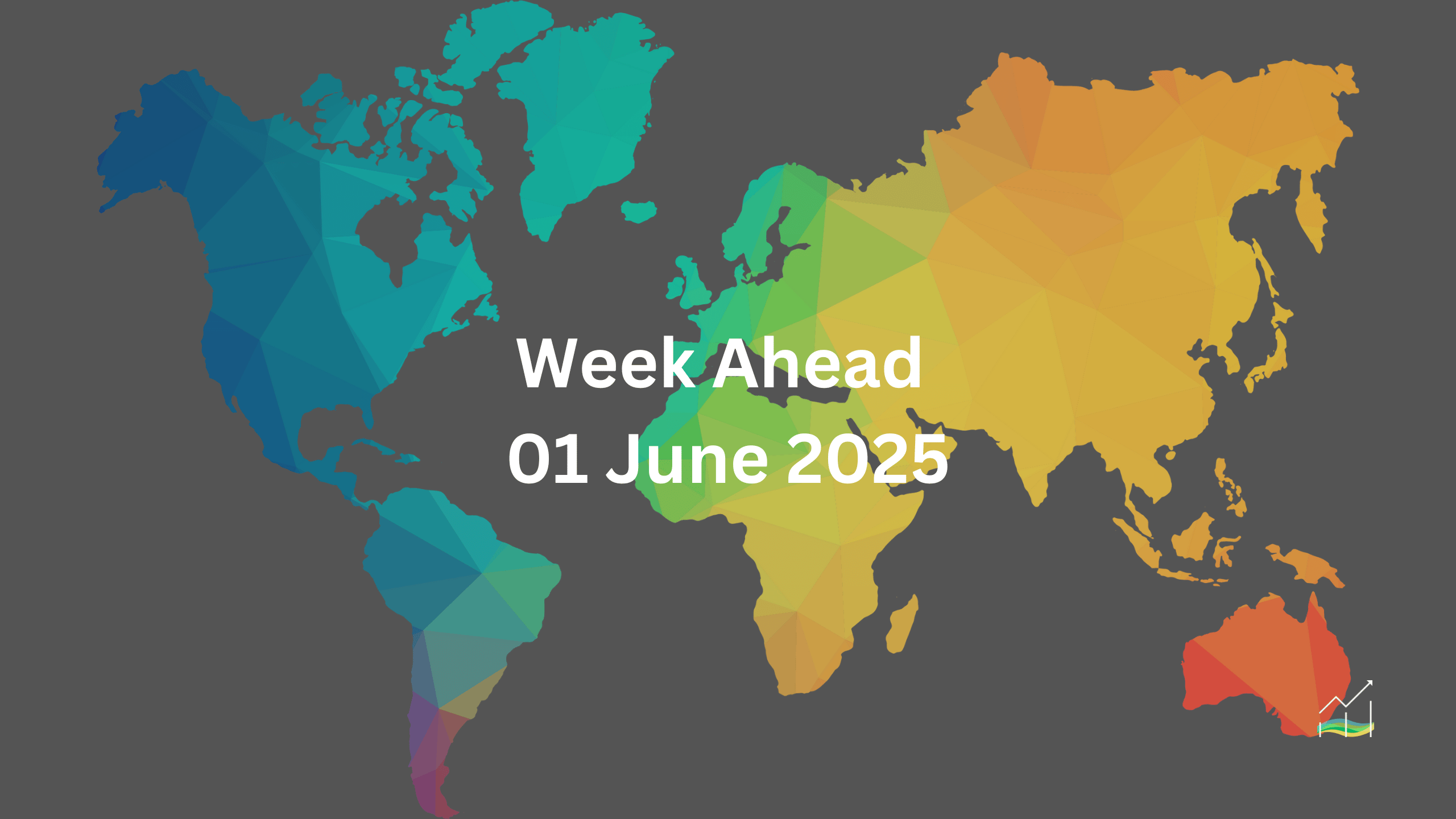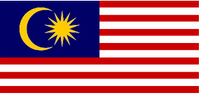01/06/2025 Week Ahead

Navigating Uncertainty: Tariff Battles & Economic Realities
Key Takeaways:
- Escalating US-China tariffs raise global economic uncertainty.
- US policy unpredictability complicates global trade.
- China’s yuan internationalization accelerates amid trade tensions.
- US economic data mixed; recession fears ease slightly.
- Investor sentiment remains cautious; US assets still attractive despite uncertainty.
Global markets remain gripped by volatility and uncertainty, driven primarily by escalating tariffs and the unpredictability of US trade policies. Recent developments highlight Washington's erratic policy shifts, including abrupt tariff announcements, postponements, and increased tariffs on steel and aluminum imports. The continued uncertainty around trade negotiations and policy reversals is complicating global supply chains and investor decision-making.
Despite a brief negotiation pause between the US and China, tariffs remain significantly higher than in previous years, creating persistent friction between the two economic giants. The US tariffs on Chinese imports average around 51%, with Chinese tariffs on American goods reaching approximately 32.5%. This strained trade environment is influencing supply chains, manufacturing costs, and overall economic growth projections, even as frantic stockpiling temporarily eased recession fears.
China, meanwhile, continues to expand the global footprint of its currency, the yuan. The issuance of yuan-denominated panda bonds by foreign entities surged significantly, reflecting growing international confidence in China's economic positioning. Concurrently, geopolitical tensions provided opportunities for China to test advanced military technologies, indicating ongoing advancements in its defense capabilities.
In the US, mixed economic signals persist. Although the first quarter showed an economic contraction influenced by tariff-driven trade distortions, modest growth has returned. However, weakened consumer sentiment, rising unemployment due to layoffs, and declining tourism bookings suggest underlying economic vulnerabilities remain. Despite these concerns, foreign investment flows into US markets increased significantly, reinforcing the continued attractiveness of US assets despite the turbulence.
Overall, navigating the current global economic environment requires careful attention to policy developments, investor sentiment, and evolving geopolitical dynamics. Investors and businesses must remain vigilant and adaptable to respond effectively to the unfolding economic landscape.
United States of America
Overview
The US economy faces headwinds as two major policy moves continue to weigh heavily on market sentiment and currency performance. Firstly, the introduction and persistence of significant tariffs have added pressure to importers, leading businesses to shrink profit margins or raise consumer prices. This outcome is clearly reflected in business surveys, which indicate a strong intent among US companies to pass increased costs onto consumers.
Secondly, the contentious budget recently passed by the House of Representatives has intensified fiscal concerns, especially after Moody's downgraded the US credit rating from AAA. This action mirrors similar downgrades by other agencies in the past, underscoring long-standing worries over fiscal responsibility and political gridlock.
Inflationary pressures remain stubbornly high, with forecasts suggesting inflation may appear especially persistent throughout May and June. Even as job growth slows modestly, the labor market remains fundamentally resilient. Only significant deterioration here would compel markets to anticipate an earlier-than-expected policy rate cut.
Bond yields have notably increased, primarily driven by rising expectations of future policy rates. Despite higher yields, the dollar has struggled to gain substantial support, indicating investor caution due to ongoing economic uncertainty.
Economic Drivers
- Continued tariffs are raising costs, shrinking business margins, and increasing consumer prices.
- Persistent inflation pressures are likely to be particularly noticeable through mid-year.
- The recent budget, amid credit downgrades, underscores ongoing fiscal and political challenges.
- Investors remain cautious, demanding higher premiums for holding dollars due to policy uncertainties.
Data and Events
- 02 June 2025: FOMC Member Waller Speaks.
- 02 June 2025: ISM Manufacturing PMI & Prices
- 03 June 2025: Fed Chair Powell Speaks.
- 03 June 2025: JOLTS Job Openings.
- 04 June 2025: ADP Non-Farm Employment Change
- 04 June 2025: ISM Services PMI.
- 05 June 2025: Unemployment Claims.
- 06 June 2025: Average Hourly Earnings.
- 06 June 2025: Non-Farm Employment Change.
- 06 June 2025: Unemployment Rate.
Price Action
- Rising yields in the 10-year and 30-year Treasuries reflect increased expectations for year-end policy rates.
- The dollar’s lackluster response to rising yields highlights broader market concerns about fiscal policy stability.
Key Points:
- Tariffs and budget issues weigh heavily on market sentiment.
- Inflation persists, complicating monetary policy outlook.
- Bond yields up due to higher policy rate expectations.
- The dollar remains weak amid sustained investor uncertainty.
Australia
Overview
The Reserve Bank of Australia (RBA) implemented its second interest rate cut of the year in May, reducing the cash rate by 25 basis points to 3.85%. Governor Bullock revealed that policymakers had even contemplated a larger 50-basis-point reduction, highlighting the central bank's dovish stance amid economic uncertainties.
Although the Australian dollar initially dipped in response to the rate cut, it swiftly rebounded towards yearly highs around $0.6515. Looking forward, the futures market currently assigns around a two-thirds probability to another quarter-point rate cut at the RBA’s next policy meeting in July. Moreover, market expectations fully account for three rate cuts by year-end, reflecting broad anticipation of continued monetary easing.
Crucial economic data to monitor ahead of the July decision includes employment figures due on June 19, inflation data scheduled for June 25, and the household spending report on July 4. These data points will be instrumental in shaping the RBA’s near-term monetary policy direction.
Economic Drivers
- Dovish RBA policy stance signaling potential further rate cuts.
- Market expectations strongly favor continued easing throughout 2025.
- Upcoming key economic indicators influencing monetary policy decisions.
Data and Events
- 03 June 2025: Monetary Policy Meeting Minutes.
- 04 June 2025: GDP.
Price Action
- Initial volatility in AUD after the rate cut, followed by recovery towards yearly highs near $0.6515.
- Technical levels suggest potential upside targets between $0.6700 and $0.6750 if resistance at $0.6550 is overcome.
Key Points:
- RBA cuts interest rate to 3.85%; hints at further easing.
- Australian dollar quickly recovered post-announcement.
- Three additional rate cuts expected by year-end.
- Upcoming data critical for July policy decision.
Canada
Overview
Canada's economic outlook remains challenged by persistently elevated core inflation, which recently surpassed a 3% annual growth rate for the first time since early 2024. This unexpected rise has notably reduced the likelihood of a Bank of Canada (BoC) interest rate cut at its upcoming policy meeting on June 4. Market expectations, which previously suggested around a 70% chance of a June rate reduction, have since halved, although most economists still lean towards anticipating a cut.
Currently, the BoC's policy rate sits at 2.75%, and markets have priced in at least one full quarter-point cut by year-end, with around a 60% likelihood of another subsequent reduction. Amidst these monetary policy adjustments, Canada's economic growth forecasts remain cautious, partly due to spillover effects from persistent disruptions in the US economy. Recent forecasts indicate Canada could face economic contraction this quarter, followed by stagnation thereafter.
While the Bank of Canada maintains a relatively optimistic growth outlook at 1.8% for the year, external forecasts appear more conservative. Bloomberg’s survey median is at 1.2%, and the International Monetary Fund (IMF) predicts 1.4% annual growth. Meanwhile, recent movements in currency markets reflect these evolving economic expectations, with the US dollar weakening against the Canadian dollar, reaching its lowest level since last October.
Economic Drivers
- Core inflation remaining stubbornly above 3%, complicating monetary policy.
- Potential economic contraction influenced by weaker US economic conditions.
- Divergent forecasts highlighting uncertainty in growth outlook.
Data and Events
- 04 June 2025: BOC Rate Statement.
- 04 June 2025: Overnight Rate.
- 04 June 2025: BOC Press Conference.
- 05 June 2025: Ivey PMI.
- 06 June 2025: Employment Change.
- 06 June 2025: Unemployment Rate.
Price Action
- Canadian dollar strengthening, with USD/CAD recently breaking below 1.37.
- Technical momentum points toward further Canadian dollar appreciation, targeting around CAD1.3400.
Key Points:
- Elevated inflation reduces expectations for imminent BoC rate cut.
- Markets anticipate at least one cut by year-end.
- Canadian economy faces near-term stagnation risks.
- Canadian dollar gaining strength against US dollar.
China
Overview
Despite widespread expectations of yuan weakness due to ongoing punitive US tariffs, the Chinese currency has strengthened significantly, recently reaching its highest level against the US dollar in six months. This surprising resilience suggests Beijing’s preference for currency stability rather than significant appreciation or depreciation, aiming to maintain competitiveness relative to trading partners in a generally weaker US dollar environment.
To support economic stability, the People's Bank of China (PBOC) recently cut key interest rates and lowered reserve requirements. It also injected additional liquidity through its one-year medium-term lending facility. However, further fiscal measures might be essential to achieving the government's stated 5% GDP growth target for this year, particularly considering persistent tariff pressures and broader geopolitical constraints.
Analysts frequently highlight weak domestic consumption as a challenge, yet consumer spending in China has consistently grown at a robust annual rate of approximately 8% since the Global Financial Crisis. The relatively smaller GDP share of consumption results from investment growing even faster, leading to widespread sectoral over-investment. This strategy reflects China's businesses prioritizing market share over immediate profitability, fueling continued economic complexities.
Economic Drivers
- Yuan stability favored by Beijing despite US tariff pressures.
- Increased PBOC monetary stimulus through rate cuts and liquidity injections.
- Persistent over-investment causing structural economic imbalances.
- Tariffs and geopolitical tensions posing headwinds to reaching GDP targets.
Data and Events
- 03 June 2025: Caixin Manufacturing PMI.
- 05 June 2025: Caixin Services PMI.
Price Action
- Yuan strengthening to six-month highs against the US dollar.
- Broad stability policy aims for competitive advantage in trade relative to other currencies.
Key Points:
- Yuan unexpectedly strong amid US tariffs.
- PBOC continues easing monetary policy to boost growth.
- Over-investment rather than weak consumption main structural challenge.
- Fiscal stimulus needed to reach 5% GDP target.
Europe
Overview
The euro has experienced significant strength against the US dollar, notably recording a 4.7% gain in April—its largest monthly rise since 2009. This surge marked the fourth consecutive monthly advance, lifting the euro to its highest level since late 2021, at around $1.1575. After a temporary correction towards support near $1.1065, the currency quickly rebounded, stabilizing around $1.1420.
The euro briefly dipped in response to the US threat of imposing a 50% tariff on EU goods. However, markets swiftly interpreted this move as primarily a negotiating tactic, especially as the US later postponed the tariff deadline to July 9. Looking ahead, the euro is expected to continue appreciating, potentially reaching around $1.1650 in the near term. Longer-term forecasts suggest further upside towards $1.20, driven primarily by investor demand for liquid alternatives to the US dollar and ongoing portfolio reallocations.
Politically, the new German government's decision to reconsider nuclear power as part of the EU’s renewable energy strategy signals greater flexibility and may open avenues for broader regional agreements. On the monetary policy front, the European Central Bank (ECB) is widely anticipated to cut interest rates by 25 basis points during its June 5 meeting, reducing the deposit rate to 2.0%. Future policy actions are expected to become less aggressive as the ECB approaches what President Lagarde has termed the "neutral rate," estimated around 1.75%.
Economic Drivers
- Market demand for a stable, liquid currency alternative to the US dollar.
- US-EU trade tensions perceived as temporary negotiating tools.
- Germany’s policy shift on nuclear energy supporting regional economic cooperation.
- ECB expected to adopt a less aggressive rate-cutting path going forward.
Data and Events
- 02 June 2025: Eurozone Manufacturing PMI.
- 03 June 2025: CPI Flash Estimate.
- 04 June 2025: Eurozone Services PMI.
- 05 June 2025: Main Refinancing Rate.
- 05 June 2025: Monetary Policy Statement.
- 05 June 2025: ECB Press Conference.
- 06 June 2025: German & French Industrial Production.
- 06 June 2025: German & French Trade Balance.
- 07 June 2025: ECB President Lagarde Speaks.
Price Action
- Strong bullish momentum driving euro to multi-year highs.
- Technical support successfully holding at approximately $1.1065.
- Short-term upside targets around $1.1650, with potential longer-term appreciation towards $1.20.
Key Points:
- Euro showing significant strength and potential for further appreciation.
- Tariff concerns seen as temporary and tactical rather than structural.
- ECB expected to continue easing at a measured pace.
- Germany’s energy policy shift potentially positive for EU cohesion.
Japan
Overview
The recent downward trend of the US dollar against the yen ended in May, with the dollar posting a modest gain of nearly 0.5% for the month. This reversal coincided with the first monthly rise in US 10-year Treasury yields after a prolonged decline. While correlations between exchange rates and US yields weakened somewhat, the yield differential between the US and Japanese bonds widened slightly, reaching about 292 basis points by month-end.
Inflationary pressures and a reduced pace of bond purchases by the Bank of Japan (BOJ) significantly impacted Japanese government bond markets. The yield on Japan’s 30-year government bonds climbed above 3% for the first time since 2001, highlighting growing stress in the long-term bond market. Despite the BOJ’s extensive ownership of Japanese government bonds, there is speculation that Japanese banks and insurers may face pressure to increase bond purchases domestically, potentially curtailing their appetite for US bonds.
In terms of international trade relations, Japan is aiming to finalize a trade agreement with the US by June, ahead of the expiration of the 90-day tariff postponement. This timing is also strategically important given the upcoming upper house elections in July.
Economic Drivers
- Elevated inflation pressures impacting bond market stability.
- BOJ reducing bond-buying pace, leading to increased bond yields.
- Potential domestic pressure on Japanese financial institutions to increase local bond holdings.
- Urgency to secure trade agreement with the US ahead of tariff deadlines and upcoming elections.
Data and Events
- 03 June 2025: 10-y Bond Auction.
- 03 June 2025: BOJ Gov Ueda Speaks.
- 05 June 2025: 30-y Bond Auction.
- 06 June 2025: Household Spending.
Price Action
- US dollar ended four-month decline against yen, briefly reaching JPY148.65.
- Important technical support at JPY140 remains critical, with a potential break indicating a long-term bearish scenario for USD/JPY.
Key Points:
- US dollar reverses recent weakness against yen in May.
- Japanese bond yields rising amid BOJ policy shifts.
- US-Japan trade deal negotiations critical ahead of July elections.
- Yen’s strength around JPY140 crucial to long-term market trends.
United Kingdom
Overview
The British pound reached new three-year highs in late May, nearing $1.3600, driven primarily by broad US dollar weakness and shifting expectations around the Bank of England’s (BOE) monetary policy. Positive economic indicators, notably stronger-than-anticipated GDP growth of 0.7% in the first quarter—the highest among G7 nations—provided substantial support to sterling's upward momentum.
Further boosting the pound were higher-than-expected inflation figures, with core inflation rising to 3.8% and services inflation increasing notably to 5.4%. Retail sales data also pointed to a robust economic environment. These factors have led markets to adjust year-end expectations for the BOE's base rate upward, from 3.50% to around 3.85%, despite the current base rate standing at 4.25%.
On the trade front, the UK achieved significant milestones by finalising a trade framework with the United States and securing a comprehensive free-trade agreement with India. Additionally, a recent deal with the EU represents a substantial step towards stabilising post-Brexit relations.
Despite these positive developments, sterling's May gains moderated compared to the substantial increase seen in April, reflecting caution among investors after a prolonged period of strength. While short-term targets around $1.3650 appear reachable, market observers caution that sterling may be nearing overextended levels following its continuous advance since early 2025.
Economic Drivers
- Strong first-quarter GDP growth outperforming G7 peers.
- Elevated core and services inflation supporting interest rate expectations.
- Improved international trade agreements with the US, India, and EU.
- Shifting market expectations for Bank of England monetary policy.
Data and Events
- 02 June 2025: Final Manufacturing PMI.
- 04 June 2025: Final Services PMI.
- 05 June 2025: MPC Member Speaks.
- 05 June 2025: Construction PMI.
Price Action
- Sterling reached nearly three-year highs around $1.3600.
- Potential near-term target of $1.3650 remains in view.
- Market sentiment cautious due to prolonged appreciation.
Key Points:
- Pound strengthened significantly due to strong economic data.
- BOE unlikely to cut rates immediately; November seen as earliest cut.
- Important trade agreements supporting sterling outlook.
- Risk of market caution given extended recent gains.
© 2025 SKONE Enterprise (003319453-V). All rights reserved.
The content on this site is for informational purposes only and does not constitute financial advice.


